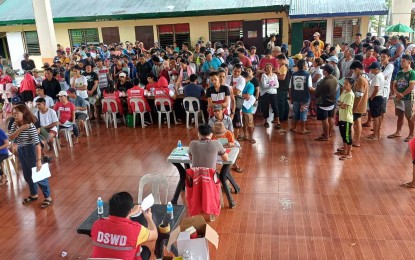
CASH AID. Indigent families in Northern Samar receive cash assistance from the national government in this undated photo. The Philippine Statistics Authority reported on Oct. 14, 2024 that one in every five families in the region was poor or had incomes that were below the poverty threshold, or the amount needed to buy their basic food and non-food needs. (Photo courtesy of Department of Social Welfare and Development)
TACLOBAN CITY – Eastern Visayas posted a 20.3 percent poverty incidence last year, lower by 1.9 percentage points from the 22.2 percent posted in 2021, officials reported on Monday.
This means that 10,264 more people in Eastern Visayas have been lifted out of poverty during the three-year period, said National Economic and Development Authority (NEDA) Assistant Regional Director Jam Colas-Villaber.
Citing data from the Philippine Statistics Authority (PSA), Villaber said that in the last seven years, the region’s poverty ranking among the 17 regions in the country has also been improving.
“The region was the third poorest in 2018 and landed in the fourth spot in 2021. The region went down one more notch on the poverty ladder and is now ranked fifth,” she said.
Among the reasons cited by the NEDA official for the lower poverty rate is the new wage increase, strengthening of government cash assistance to the poor, and the absence of destructive natural calamities in most parts of the region last year.
“We need more efforts to eradicate poverty since the reduction is still below the target of the Regional Development Plan. There are still 1.34 million people in Eastern Visayas living in poverty,” Villaber added.
A family of five in Eastern Visayas needed at least PHP13,492 monthly to sustain their basic food and non-food needs last year. The poverty threshold amount is higher than the PHP11,187 monthly income requirement in 2021.
“The poverty incidence of 20.3 (percent) among families implies that about one in every five families in the region was poor or had incomes that were below the poverty threshold, or the amount needed to buy their basic food and non-food needs,” Philippine Statistics Authority Eastern Visayas (PSA) Regional Director Wilma Perante said.
Five of the region’s six provinces managed to bring down poverty levels in the past three years.
Only Northern Samar province recorded a worsened poverty rate from 19.3 percent to 21.8 percent. This is largely driven by massive flooding in the province in late 2023, according to NEDA.
Other provinces have recorded improvements between 2021 and 2023.
In Samar, poverty incidence was estimated at 24.9 percent, the highest in the region. In 2021, the province recorded a 27 percent poverty rate.
Eastern Samar logged a poverty incidence of 24.7 percent, a reduction from 29.4 percent two years ago.
Leyte’s figure slightly dropped to 21.7 percent in 2023 from 22 percent in 2021.
Biliran’s poverty significantly dropped to 8.5 percent from 19.9 percent. Southern Leyte’s figure also remarkably went down to 7.1 percent from 16 percent.
Tacloban City, the lone highly urbanized city in the region, recorded a poverty incidence of 10.6 percent in 2023, slightly lower than the 10.7 percent recorded two years ago.
PSA came up with these figures based on the 2023 Family Income and Expenditure Survey.
The study examines the family's income and capacity to meet basic food requirements based on the 100 percent adequacy of the recommended energy and nutrient intake and the 80 percent adequacy of other nutrients.
It also investigates the ability of families' income to provide basic non-food requirements such as clothing and footwear, housing, fuel, light, water, maintenance and minor repairs, healthcare, education, transportation and communication, furniture, household operations, and personal care. (PNA)
